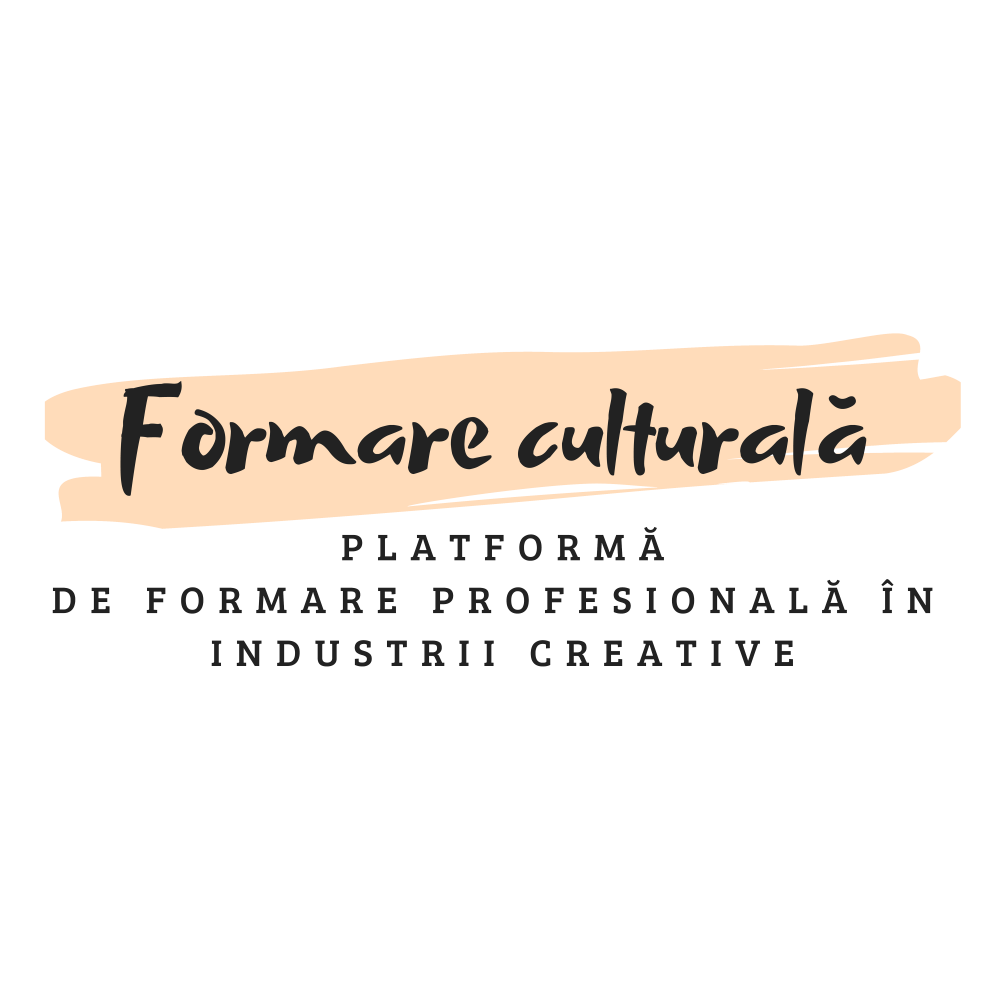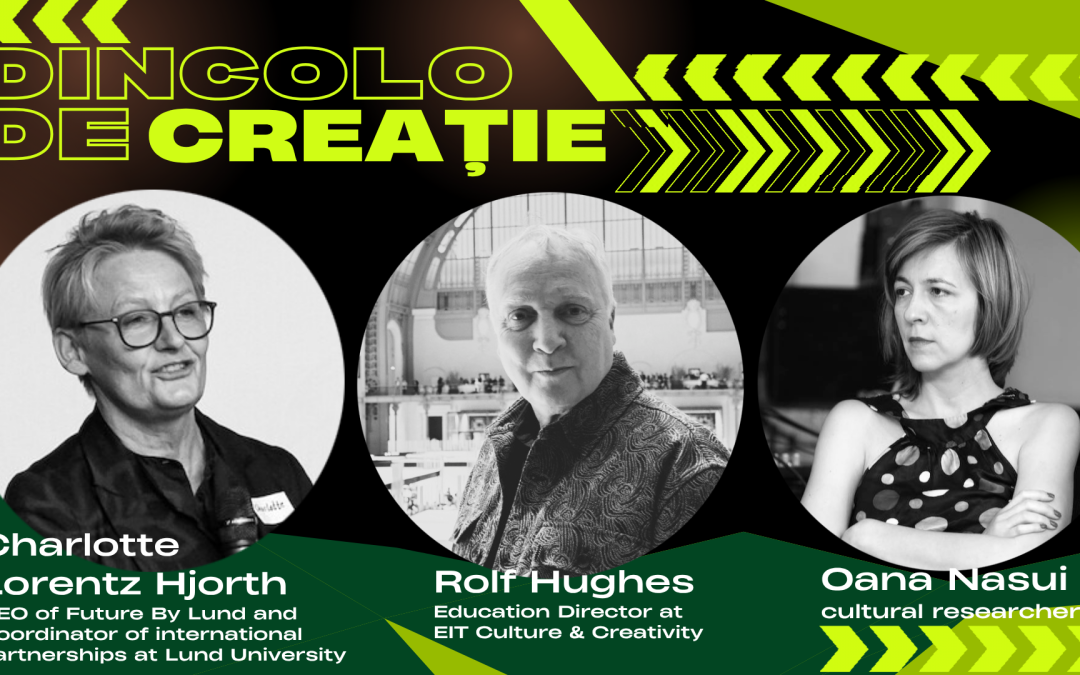This panel discussion, part of the “Beyond Creation” project produced by Formare Culturala platform, a parallel event in Creative Skills Week 2025, brings together Charlotte Lorentz Hjorth (CEO of Future By Lund and coordinator at Lund University), Rolf Hughes (Education Director at EIT Culture & Creativity), and moderator Oana Nasui (cultural researcher from Romania) to explore how creative ecosystems can become more sustainable and inclusive across Europe.
Building Bridges Between Academia, Industry and Culture
Charlotte begins by explaining her multifaceted role at Lund University, where she works to break down silos between nine different faculties using culture and creative industries as a catalyst for collaboration. Her work extends beyond the university through Future By Lund, an innovation platform created with industry partners and the city. This platform uses what they call a “portfolio approach” to create cross-innovation partnerships between different faculties, industries, and European networks.
A major project Charlotte coordinates is EKIP, a Horizon Europe project with 80-90 people working across Europe to build a policy platform for innovation. The project focuses on opening up innovation ecosystems to better include culture and creative industries, which have traditionally been excluded. Charlotte explains that established ecosystems like Lund’s science park—nearly 50 years old and one of Scandinavia’s first—have been very good at technology-driven innovation but struggled to accommodate the many small companies in the creative sector that don’t fit neatly into specialized incubators.
From Local Prototypes to European Policy
When Oana asks about the target audience for these policies, Charlotte reveals EKIP’s strategic approach: they decided to work simultaneously on European and city levels, letting the middle layers sort themselves out. They work with prototype cities—starting with four, now expanding to ten across Europe—testing policy recommendations in real innovation portfolios with a bottom-up approach. These local experiments are complemented by policy dialogues at national levels, with recent or planned sessions in Greece, Milan, Stockholm, and Kosovo.
Oana observes that this is actually a sustainable model, noting that with so much raw information available, it’s crucial to have a clear vision of what you want to achieve.
Charlotte emphasizes that “it’s the policy journey that is important”—the iterative process of looking at local cases, understanding needs, and helping cities adapt recommendations to their specific contexts. She highlights a critical barrier: smart specialization strategies that fund ecosystem functions have rarely targeted culture and creative industries, meaning structural funds often can’t be used for this sector. This necessitates finding alternative ways to engage communities and integrate creatives into existing ecosystems rather than building separate ones.
The EIT Culture & Creativity Framework
Oana invites Rolf to share his work as education director at EIT Culture & Creativity, asking him to pinpoint what would be of interest to listeners—to see the vision and structure, and how individuals can take advantage of this huge pile of resources.
Rolf Hughes then provides insight into the newest Knowledge Innovation Community (KIC), explaining that EIT Culture & Creativity was established in 2023 as the ninth KIC, joining others focused on climate, health, food, urban mobility, energy, and digital innovation. The KIC operates through three main pillars—education, business creation, and innovation—plus a fourth transformation pillar looking at societal impacts.
In education, Rolf oversees two main funding mechanisms: degree education calls that support modules in master’s and PhD programs focusing on entrepreneurship and innovation, and lifelong learning programs divided into EIT-labeled courses (meeting quality benchmarks) and non-labeled skills-based training. The organization has grown rapidly from about 15-20 people at the start of 2024 to 60-65 within nine months.
The KIC operates through five strategic priority areas: architecture, cultural heritage, fashion, gaming, and audiovisual media. Rolf has introduced two additional focus areas: youth entrepreneurship to establish early awareness of entrepreneurial possibilities, and emerging technologies including AI, virtual reality, and augmented reality. He emphasizes the importance of cross-KIC collaboration, noting that “the world has problems and universities have departments”—and similarly, EIT risks creating nine silos that need bridging.
Reimagining Learning Spaces and Access
Rolf envisions an ambitious future where the six regional Co-Location Centers (CLCs) across Europe—in Helsinki, Amsterdam, Košice, Vienna, Barcelona, and Bologna—could serve as physical hubs for blended learning that combines online accessibility with face-to-face encounters. He sees potential for learning to move beyond “castles on the hill” into everyday spaces like libraries, hotel foyers, and theater lobbies during off-hours.
A particularly exciting development is AI’s capability for simultaneous translation, which Rolf believes could remove language as a barrier to participation. Someone could speak in English while listeners choose to hear in Portuguese, Romanian, or languages beyond the EU. This technology, combined with platforms like Maestra and YouTube’s translation features, is already expanding reach for regional content creators.
Oana jumps in with practical information about AI tools currently available, mentioning Maestra which provides simultaneous captions, and YouTube’s immediate translation feature. She notes how Romanian videos can now be immediately translated into English, suddenly opening up a much broader market and audience—a great gain for local knowledge like crafting when it comes to heritage and local traditions. This technology is already expanding reach for regional content creators.
Cross-Disciplinary Innovation Models
Charlotte introduces the theoretical framework guiding EKIP’s policy work using a visual model of cross-innovation ecosystems. Unlike traditional open innovation—where an organization ventures out to bring in external competencies then returns to test them—cross-innovation starts in the ecosystem itself. Different stakeholders explore challenges together in what she calls the “yellow zone” of free knowledge sharing and cross-fertilization.
From these exploratory phases, specific challenges emerge that smaller groups test in collaborative projects (the “green zone”), similar to developing concept cars. The insights and solutions then get absorbed into individual organizations (the “blue zone”) to fertilize their development work. Charlotte emphasizes the importance of cultural policy and innovation policy working together: cultural funding might support a theater while innovation policy treats it as a testbed for new ideas, giving creatives access to dual funding streams if they understand the distinction.
She stresses that universities need to resist becoming mere consultancies where companies arrive with tight briefs. Instead, the yellow zone should offer more open exploration of trends and new technologies, creating student projects and partnerships from shared discoveries rather than predetermined problems. This messier approach suits creatives particularly well, as they excel at interpretation, creating common language, and setting vision.
Redefining Innovation for Creative Contexts
When Oana poses the challenging question of what innovation actually means, Charlotte provides a nuanced answer. Innovation exists on a scale from incremental improvements in new contexts to radically transformative changes. It can occur in processes, methods, services, or products. Crucially, she distinguishes between invention—solving a problem to create something new—and innovation, which only occurs when that solution is used in practice or brought to market.
This distinction becomes especially important when working with city cultural departments, where civil servants understand cultural policy focused on individual artists, intellectual property, and copyright, but struggle with innovation policy oriented toward market outcomes. Charlotte’s team has worked to show how these policy frameworks can complement rather than compete: “if we can combine cultural policy with innovation policy, the creatives can have double win.”
She’s careful to note that art should remain unmolested on its own terms, but emphasizes that creating art requires numerous innovations in tools, technologies, and outreach. The goal is symbiosis between these worlds without destroying either.
Artistic Research as Innovation Driver
Rolf frames artistic research as potentially the symbiosis Charlotte describes—existing between artistic exceptionalism and market pragmatism. Artistic research uses the specific tools of arts (dance, ceramics, filmmaking, acting) based on the premise that certain research insights can only be arrived at through these means, not through theoretical work or conceptualization alone.
He argues that structured bridges need connecting the experimental, exploratory, and critical inquiry of artistic research with strategic market demands. This happens through integrating entrepreneurial education into creative practice—teaching business model design, intellectual property management, strategic planning, and financial literacy in ways relevant to creative practitioners.
Rolf provides two compelling Swedish examples. The first involves the experience design master’s program he founded at Konstfack, which collaborated with palliative care facilities in Stockholm and Umeå. Instead of conventional design interventions (changing colors, improving windows), students examined how time is experienced differently by dying patients, staff, and visiting families. Their time-based interventions redesigned rituals around visiting hours, leading to successful research applications now being implemented across multiple palliative care institutes.
The second example is the Stockholm School of Entrepreneurship, originally funded by H&M foundation to address gaps in Swedish entrepreneurship education. It serves as a hub for five or six Stockholm universities—Business School, Royal Institute of Technology, Stockholm University, Karolinska (health), Konstfack (arts), and Royal Music School. When highly motivated students from these diverse institutions gather with tools like design thinking, they pragmatically exchange skills, tools, perspectives, and worldviews without being constrained by 19th-century disciplinary categories.
Understanding Ventures and Funding Models
Oana poses a specific question about ventures, noting that people are usually familiar with firms, creative boutiques, nonprofit organizations, universities, and funding bodies, but Rolf mentioned a mixed type of funding. She asks him to guide the audience through how the label system works—where external entities provide courses for the academy, and there are also fee-based courses like a normal academy. How does this ecosystem actually function?
Rolf explains they’re just at the beginning of this process, having only been operational since early 2024 when the grant agreement was signed in December 2023. The venture model allows members to select projects based on seed funding for one year using membership money. Three projects received capital to test their ideas, and business developers created business models for each. In the case of the craft academy, the conclusion was that it wouldn’t be sustainable as a standalone venture, so it’s been included in the business plan as part of a larger academy of creative entrepreneurship—an umbrella organization for multiple satellite academies.
What the venture model provides is flexibility not bound by standard EIT regulations, allowing more creative funding models and creating alternative revenue streams. They’re exploring sponsorships, a mixture of in-house and externally commissioned courses, and building a teaching team they can call upon. Rolf emphasizes the “Hotel California effect”—participants might enter through education, then be channeled toward business creation, then innovation, then back to education, creating ongoing value for alumni rather than just one-off courses.
Conclusion
The discussion reveals a sophisticated understanding of how sustainable creative ecosystems require simultaneous work at multiple scales, bridging traditional divides between art and commerce, research and practice, local and European levels. Both Charlotte and Rolf emphasize the importance of interdisciplinary collaboration, flexible funding models, and recognizing that culture and creativity are not just sectors unto themselves but potential facilitators for addressing complex, multi-layered societal challenges. The initiatives they describe—from EKIP’s policy platform to EIT’s educational programs—represent evolving models for integrating creative practitioners into innovation ecosystems while respecting the distinct value of artistic practice.
/// The project “Beyond creation” is co-financed by the Administration of the National Cultural Fund More, here


